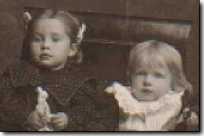by Bev Qualheim - Copyright 2002, 2017

When I began my interest in Family History research, I had very little to go on; a few names I remember my mom and dad talking about. Then a couple more names from an old family Bible my Aunt Mary had. So my search has been from scratch, and has often led to dead ends, even after 20 years. Why would anyone be interested in pursuing such a hobby you might ask? Well, in spite of dead ends, I have also been able to find information on several lines way back into the 1100's and father back with Royal lines as history recorded them. I have found new 'cousins'. I have cheered out loud as I discovered a brand new name to add to my ever growing family. It is an amazing journey that branches out just like a glorious oak tree. It's arms reaching upward and it's roots firm, keeping my family grounded in many ways. Many people have asked how they can begin this journey and I would like to give you some ideas of how to do this.
How to Start
Write down the follow ing about you, your children, spouse, and your parents on our handy printable PEDIGREE CHART. This will print in 2 pages that you can tape together.
1.
Write down full names. If you are a married woman, be sure
to
use your maiden names on genealogical papers.
2.
Birthdates and places. Please include the city, state/province,
and
country.
3.
Dates and places of marriages.
4.
What were their parents names, birthdates, places.
5.
When did their parents marry and where.
6.
Death dates and places. Burial places and dates if possible.
Now work backward, one generation at a time gathering information about your parents, grandparents, and so on. Names, dates, and places should always be documented by reference to the records where the information was found. This is really important in case you run across conflicting information. If you found the information on a Primary Source, such as a birth certificate, or death certificate, your information is likely to be correct, but many researches like to back up their dates etc with more than one reliable source. You can note the sources on the bottom of your pedigree chart if you wish.
As soon as you get
even a few starting names, go to
Family Search - It's FREE!
You can register, then sign in anytime you want (SIGN IN is in the
upper right hand corner). You can find research others have
done, add photos and add the names, dates and such about your
ancesters. I love the pedigree fan chart they have
too!! After you start entering info, you can see and print a fan
chart of your ancesters showing who is missing and what information you
need.
When you run into dead ends
WRITING
emails or LETTERS:
* Use email,
Facebook etc. or write a physical letter. If you do the latter always
enclose
an SASE (Self Addressed Stamped Envelope) or enough money to cover
postage.
* Send a few
specific questions
about specific relatives. Don't be too general asking someone to
send everything they know about your family!
* Make sure to type
or write
the letter very neatly.
* The best results I ever
got, were the times I wrote the questions on a separate piece of
paper,
and numbered with spaces for the relative to place the answers.
* Always offer to
share
any family information/pedigrees you are able to gather.
Online
Resources
I have many
favorite, FREE, family
history pages that I turn to when I am stuck on a certain name:
http://www.genforum.com
(Find a bulletin board for your surnames and post any info you might
have.
People who can help, will write!)
http://searches.rootsweb.com/
http://www.ancestry.com
http://www.familysearch.org
http://www.cyndislist.com/
(A truly amazing online compilation)
http://www.kindredkonnections.com/
http://www.surnameweb.org/
http://olivetreegenealogy.com/index.shtml
http://www.familytreemaker.com
http://www.genealogy.com/links
http://www.familyhistory.com
http://www.sanbachs.net/cdi.html
(The Computerized Ancestor)
http://www.gengateway.com
http://www.geneanet.org
http://www.usgenweb.org
http://www.genuki.org.uk
http://www.feefhs.org
(Federation of Eastern European Family History Societies)

You might want to start off right away keeping track of what you find, in a scrapbook.
It is possible to make a 'Scrapbook' to create a beautiful Family History Record. You would need a few basics like:
1) Acid Free/Archive Quality paper
-you can print up any historical information, family stories etc on this.
2) Photo paper to copy the photos (Kodak works best for me)
3) Acid free clear folders
4) Acid Free 3 Ring Binder
5) Photo safe glue stick
A few suggestions:
* Rather than paste
original
old photos, it is best to make copies by scanning and then printing.
* You can also use a
photo
program like photoshop or Paint shop pro to improve the look of old,
faded
photos.
* Since old black and
white
photos are made up of several layers including an emulsion layer, made
up of organic materials, photos are likely to mold if they are exposed
to hot temps (over 70F) or in damp areas such as found in basements.
* Keep the old photos in
a cool, low humidity environment, in photo boxes, so that the photos do
not touch each other, and keep negatives from touching each other or
the
photos, as they will stick.
* You can use a
genealogy/family
history program to type up and store your data.
* That can be printed
off
on your acid free paper too and added to the scrapbook, next to photos.
:-)
* Save your work on cds
or zip disks also so you can print off copies for relatives. They can
also
be a great source of information for you too.
Family History is an amazing journey into who you are. We all have parts of our own past within us, giving us strength, helping us become who we are today. I hope this will get you started on your road to finding many of your ancestors.
~~~~~~~~~~~~~~~~~~~~~~~~~~~~~~